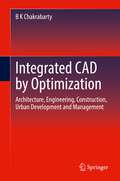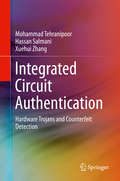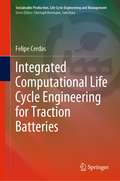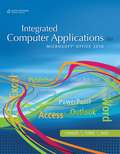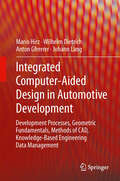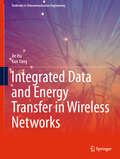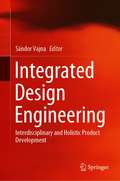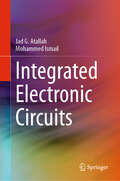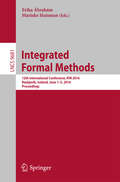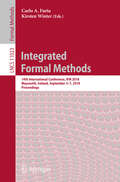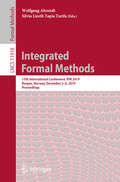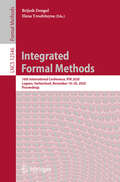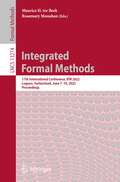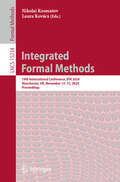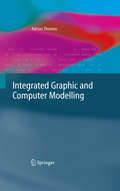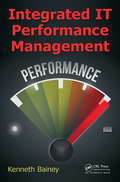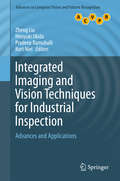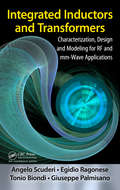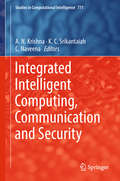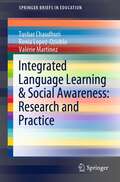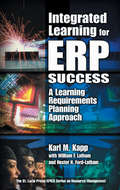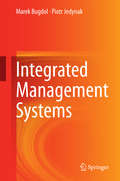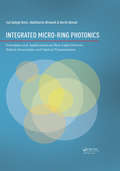- Table View
- List View
Integrated CAD by Optimization: Architecture, Engineering, Construction, Urban Development and Management
by B K ChakrabartyThis book presents range of topics concerning integrated CAD (including Optimization) for use in Architecture (including Planning), Civil Engineering and Construction (AEC), and thus, helps introduce a full-length treatment of the subject, enabling practitioners to adopt an Integrated Computer-Aided Design Approach in their professional activity. The book gives to readers an understanding of the main elements of CAD, highlighting the importance of integrating these elements and the applicability of Integrated CAD in AEC. Many examples and problems (including Optimization) are included to help professionals and students to develop and apply such tools in solving problems in AEC field. Adopts a problem solving approach in planning, design, and management stressing IT and Computer Application in AEC sector as a whole;Emphasizes resource-efficiency and social equity in problem solution in the AEC sector in general, and in urban development and management in particular;Stresses optimization and an integrated approach covering all components, including costs, affordability and environmental factors, scarcity of resources, and resolution of conflicting interests;Includes an accessible overview and source codes of C++ and Auto Lisp programs needed to carry out design analysis, optimization and drafting-drawing in an integrated manner.
Integrated Circuit Authentication
by Mohammad Tehranipoor Hassan Salmani Xuehui ZhangThis book describes techniques to verify the authenticity of integrated circuits (ICs). It focuses on hardware Trojan detection and prevention and counterfeit detection and prevention. The authors discuss a variety of detection schemes and design methodologies for improving Trojan detection techniques, as well as various attempts at developing hardware Trojans in IP cores and ICs. While describing existing Trojan detection methods, the authors also analyze their effectiveness in disclosing various types of Trojans, and demonstrate several architecture-level solutions.
Integrated Computational Life Cycle Engineering for Traction Batteries (Sustainable Production, Life Cycle Engineering and Management)
by Felipe CerdasThe environmental burden caused by private transportation represents a significant challenge towards sustainability. Electric vehicles are considered a key technology to reduce the environmental impact caused by the mobility sector. However, the global adoption of electromobility implies shift and diversification of the environmental impacts caused by the transportation sector mainly driven by the production of the battery system. Modeling the life cycle environmental impacts of traction batteries is a time demanding and interdisciplinary task as it involves a high variability and requires an in-depth knowledge of the product system under analysis. To face these challenges, an Integrated Computational Life Cycle Engineering ICLCE framework for EVs has been developed. The ICLCE framework described aims at supporting fast and comprehensive modelling of complex foreground systems in the electromobility field and their interaction with diverse backgrounds and partial contexts.
Integrated Computer Applications with Multimedia & Input Technologies, 4th Edition
by Susie H. Vanhuss Connie M. Forde Donna L. Woo Linda HefferinIntegrated Computer Applications is a comprehensive text that teaches essential Microsoft Office 2003 skills and applies them in numerous integrated projects. You'll begin with a brand new Microsoft Word module that thoroughly reviews all commonly used document formats and word processing skills. Twelve integrated projects challenge you to apply your knowledge and integrate your software skills.
Integrated Computer Applications: Microsoft® Office 2010
by Susie H. Vanhuss Connie M. Forde Donna L. WooINTEGRATED COMPUTER APPLICATIONS 6E challenges users to combine all of the tools of Microsoft Office 2010 plus Web computing to create relevant workplace solutions. Real-world projects plus an easy-to-learn format integrate newly learned skills and apply it in meaningful applications just as employees in industry are required to do.
Integrated Computer-Aided Design in Automotive Development: Development Processes, Geometric Fundamentals, Methods of CAD, Knowledge-Based Engineering Data Management
by Anton Gfrerrer Hirz Mario Johann Lang Wilhelm DietrichThe automotive industry faces constant pressure to reduce development costs and time while still increasing vehicle quality. To meet this challenge, engineers and researchers in both science and industry are developing effective strategies and flexible tools by enhancing and further integrating powerful, computer-aided design technology. This book provides a valuable overview of the development tools and methods of today and tomorrow. It is targeted not only towards professional project and design engineers, but also to students and to anyone who is interested in state-of-the-art computer-aided development. The book begins with an overview of automotive development processes and the principles of virtual product development. Focusing on computer-aided design, a comprehensive outline of the fundamentals of geometry representation provides a deeper insight into the mathematical techniques used to describe and model geometrical elements. The book then explores the link between the demands of integrated design processes and efficient data management. Within automotive development, the management of knowledge and engineering data plays a crucial role. Some selected representative applications provide insight into the complex interactions between computer-aided design, knowledge-based engineering and data management and highlight some of the important methods currently emerging in the field.
Integrated Data and Energy Transfer in Wireless Networks (Textbooks in Telecommunication Engineering)
by Kun Yang Jie HuThis textbook offers a comprehensive guideline for integrated data and energy transfer, from theoretical fundamentals to practical implementations and applications. This book is suitable for students, engineers and scientists in electronic engineering who are interested in the integrated data and energy transfer in future wireless networks. The authors cover waveform and transceiver design in the physical layer, resource allocation and medium access control protocol, networking and deployment as well as practical implementation of the wireless integrated data and energy transfer. The authors commence from information theoretical fundamentals, physical layer design principles, medium access control, and networking techniques. The book ends with a practical prototype of integrated data and energy transfer. The book is geared towards graduate students and senior undergrads having a general background of wireless communications. The book features exercises, Q&A, and examples throughout.
Integrated Design Engineering: Interdisciplinary and Holistic Product Development
by Sándor VajnaThis book addresses Integrated Design Engineering (IDE), which represents a further development of Integrated Product Development (IPD) into an interdisciplinary model for both a human-centred and holistic product development. The book covers the systematic use of integrated, interdisciplinary, holistic and computer-aided strategies, methods and tools for the development of products and services, taking into account the entire product lifecycle. Being applicable to various kinds of products (manufactured, software, services, etc.), it helps readers to approach product development in a synthesised and integrated way.The book explains the basic principles of IDE and its practical application. IDE’s usefulness has been demonstrated in case studies on actual industrial projects carried out by all book authors. A neutral methodology is supplied that allows the reader to choose the appropriate working practices and performance assessment techniques to develop their product quickly and efficiently. Given its manifold topics, the book offers a valuable reference guide for students in engineering, industrial design, economics and computer science, product developers and managers in industry, as well as industrial engineers and technicians.
Integrated Electronic Circuits
by Mohammed Ismail Jad G. AtallahThis textbook takes a unique approach to fundamental courses in electronic circuits, providing the students with early exposure to Integrated Circuit (IC) technology and Electronic Design Automation (EDA) tools using a Process Design Kit (PDK). This aims at preparing the students to participate in the advancements taking place in the field today and in the foreseeable future. The book follows a novel, hands-on approach to electronics education, combining a unique pedagogy that balances theory with practice. The starting point consists of circuit simulation results rather than device physics. Therefore, hand calculations and simulations are readily used, and the loop between the two is closed. The information is presented visually not only for the circuits, but also for the signals involved, all of which being simulation results. The book is aimed to be easily read and understood by the students, which gives the instructors ample time to concentrate on the important points. The book discusses technology and its applications and limitations along with the IC design flow. It goes in depth into various types of circuits including analog, digital, and mixed-signal, where the students are encouraged to discover the connections between the different applications. This is because future electronic circuit designers should be able to understand system and technology aspects, and be able to switch easily between applications. This results in the students being better-prepared for future cross-disciplinary innovations.
Integrated Formal Methods
by Erika Ábrahám Marieke HuismanThis bookconstitutes the refereed proceedings of the 12th International Conference on IntegratedFormal Methods, IFM 2016, held in Reykjavik, Iceland, in June 2016. The 33 paperspresented in this volume were carefully reviewed and selected from 99submissions. They were organized in topical sections named: invitedcontributions; program verification; probabilistic systems; concurrency; safetyand liveness; model learning; SAT and SMT solving; testing; theorem proving andconstraint satisfaction; case studies.
Integrated Formal Methods: 14th International Conference, IFM 2018, Maynooth, Ireland, September 5-7, 2018, Proceedings (Lecture Notes in Computer Science #11023)
by Carlo A. Furia Kirsten WinterThis book constitutes the refereed proceedings of the 14th International Conference on Integrated Formal Methods, IFM 2018, held in Maynooth, Ireland, in September 2018.The 17 full papers and 5 short papers presented together with 3 invited talks were carefully reviewed and selected from 60 submissions. The conference covers a broad spectrum of topics: from language design, to verification and analysis techniques, to supporting tools and their integration into software engineering practice.
Integrated Formal Methods: 15th International Conference, IFM 2019, Bergen, Norway, December 2–6, 2019, Proceedings (Lecture Notes in Computer Science #11918)
by Wolfgang Ahrendt Silvia Lizeth Tapia TarifaThis book constitutes the refereed proceedings of the 15th International Conference on Integrated Formal Methods, IFM 2019, held in Bergen, Norway, in December 2019.The 25 full papers and 3 short papers were carefully reviewed and selected from 95 submissions. The papers cover a broad spectrum of topics: from language design to verification and analysis techniques, to supporting tools and their integration into software engineering practice including both theoretical approaches and practical implementations. Also included are the extended abstracts of 6 "journal-first" papers.
Integrated Formal Methods: 16th International Conference, IFM 2020, Lugano, Switzerland, November 16–20, 2020, Proceedings (Lecture Notes in Computer Science #12546)
by Elena Troubitsyna Brijesh DongolThis book constitutes the refereed proceedings of the 16th International Conference on Integrated Formal Methods, IFM 2019, held in Lugano, Switzerland, in November 2020. The 24 full papers and 2 short papers were carefully reviewed and selected from 63 submissions. The papers cover a broad spectrum of topics: Integrating Machine Learning and Formal Modelling; Modelling and Verification in B and Event-B; Program Analysis and Testing; Verification of Interactive Behaviour; Formal Verification; Static Analysis; Domain-Specific Approaches; and Algebraic Techniques.
Integrated Formal Methods: 17th International Conference, IFM 2022, Lugano, Switzerland, June 7–10, 2022, Proceedings (Lecture Notes in Computer Science #13274)
by Maurice H. ter Beek Rosemary MonahanThis book constitutes the refereed proceedings of the 17th International Conference on Integrated Formal Methods, IFM 2022, held in Lugano, Switzerland, in June 2022. The 14 full papers and 2 short papers were carefully reviewed and selected from 46 submissions. The papers are categorized into the following topical sub-headings: Invited Papers; Cooperative and Relational Verification; B Method; Time; Probability; learning and Synthesis; Security; Stats Analysis and Testing; PhD Symposium Presentations.
Integrated Formal Methods: 19th International Conference, IFM 2024, Manchester, UK, November 13–15, 2024, Proceedings (Lecture Notes in Computer Science #15234)
by Nikolai Kosmatov Laura KovácsThis volume LNCS constitutes the refereed proceedings of the 19th International Conference on Integrated Formal Methods, IFM 2024, during 13-15 November 2024, held in Manchester, UK. The 19 full papers presented in this volume were carefully reviewed and selected from 58 submissions. The conference focuses on all aspects of the design of integrated techniques, including language design, verification and validation, automated tool support, and the use of such techniques in software engineering practice.
Integrated Graphic and Computer Modelling
by Adrian ThomasComputer languages and computer graphics have become the primary modes of human-computer interaction. This book provides a basic introduction to "Real and Virtual Environment" computer modelling. Graphics models are used to illustrate both the way computer languages are processed and also used to create computer models of graphic displays. Computer languages have been bootstrapped from machine code, to high-level languages such as Java, to animation scripting languages. Integrating graphic and computer models takes this support for programming, design and simulation work, one step further, allowing interactive computer graphic displays to be used to construct computer models of both real and virtual environment systems. The Java language is used to implement basic algorithms for language translation, and to generate graphic displays. It is also used to simulate the behaviour of a computer system, to explore the way programming and design-simulation environments can be put together.
Integrated IT Performance Management
by Kenneth BaineyIf you are in search of real-world practical scenarios of IT performance management practices, with a desire to obtain examples of strategic directives, accountabilities, outcomes, and performance measures for managing IT services, with an interest toward how performance management integrates with strategic and operational management, then Integrat
Integrated Imaging and Vision Techniques for Industrial Inspection
by Zheng Liu Hiroyuki Ukida Pradeep Ramuhalli Kurt NielThis pioneering text/reference presents a detailed focus on the use of machine vision techniques in industrial inspection applications. An internationally renowned selection of experts provide insights on a range of inspection tasks, drawn from their cutting-edge work in academia and industry, covering practical issues of vision system integration for real-world applications. Topics and features: presents a comprehensive review of state-of-the-art hardware and software tools for machine vision, and the evolution of algorithms for industrial inspection; includes in-depth descriptions of advanced inspection methodologies and machine vision technologies for specific needs; discusses the latest developments and future trends in imaging and vision techniques for industrial inspection tasks; provides a focus on imaging and vision system integration, implementation, and optimization; describes the pitfalls and barriers to developing successful inspection systems for smooth and efficient manufacturing process.
Integrated Imaging and Vision Techniques for Industrial Inspection: Advances and Applications (Advances in Computer Vision and Pattern Recognition)
by Zheng Liu Hiroyuki Ukida Pradeep Ramuhalli Kurt NielThis pioneering text/reference presents a detailed focus on the use of machine vision techniques in industrial inspection applications. An internationally renowned selection of experts provide insights on a range of inspection tasks, drawn from their cutting-edge work in academia and industry, covering practical issues of vision system integration for real-world applications. Topics and features: presents a comprehensive review of state-of-the-art hardware and software tools for machine vision, and the evolution of algorithms for industrial inspection; includes in-depth descriptions of advanced inspection methodologies and machine vision technologies for specific needs; discusses the latest developments and future trends in imaging and vision techniques for industrial inspection tasks; provides a focus on imaging and vision system integration, implementation, and optimization; describes the pitfalls and barriers to developing successful inspection systems for smooth and efficient manufacturing process.
Integrated Inductors and Transformers: Characterization, Design and Modeling for RF and MM-Wave Applications
by Giuseppe Palmisano Egidio Ragonese Angelo Scuderi Tonio BiondiWith the ability to improve performance, reduce fabrication costs, and increase integration levels of both RX and TX sections of the RF/mm-wave front-end, passive inductive components have experienced extraordinary growth in ICs. Therefore, a fundamental understanding of monolithic inductors and transformers has become essential for all process eng
Integrated Intelligent Computing, Communication and Security (Studies in Computational Intelligence #771)
by A. N. Krishna K. C. Srikantaiah C NaveenaThis book highlights the emerging field of intelligent computing and developing smart systems. It includes chapters discussing the outcome of challenging research related to distributed computing, smart machines and their security related research, and also covers next-generation communication techniques and the networking technologies that have the potential to build the future communication infrastructure. Bringing together computing, communications and other aspects of intelligent and smart computing, it contributes to developing a roadmap for future research on intelligent systems.
Integrated Language Learning & Social Awareness: Research and Practice (SpringerBriefs in Education)
by Tushar Chaudhuri Renia Lopez-Ozieblo Valérie MartinezThis book reports on and analyses the Integrated Language Learning & Social Awareness Project, a unique project in the field of Foreign Language Learning and Telecollaboration till now in the world. It takes the existing research on telecollaborative learning, content and language integrated learning and e-learning and combines them into one coherent concept in which language acquisition and enhancement takes place through task-led research on the specific issue of “Healthy Cities” by targeting language learners from around the world. The book delivers insights into the planning and the development of the project including collaborative task design and its underlying theoretical and research frameworks. It then goes on to reflect on how these underlying frameworks are developed further to broaden the existing paradigms of research in the field of telecollaborative language learning.
Integrated Learning for ERP Success: A Learning Requirements Planning Approach (Resource Management)
by Karl M. Kapp William F. Latham Hester Ford-LathamThe results are in. The evidence has been analyzed. Research shows that the lack of enterprise-wide training is the biggest reason for ERP implementation failures. It is the single most important precursor to achieving success. Integrated Learning for ERP Success is the first resource to offer a specifically defined, comprehensive method fo
Integrated Management Systems
by Marek Bugdol Piotr JedynakExamining the challenges of integrated management, this book explores the importance and potential benefits of using an integrated approach as a cross-functional concept of management. It covers not only standardized management systems (e. g. International Organization for Standardization), but also models of self-assessment, as well as different types of integration. Furthermore, it demonstrates how processes and systems can be integrated, and how management efficiency can be increased. The major part of this book focuses on management concepts which use integration as a key tool of management processes (e. g. the systematic approach, supply chain management, virtual and network organizations, processes management and total quality management). Case studies, illustrations, and tables are also provided to exemplify and illuminate the content, as well as examples of successful and failed integrations. Providing a particularly useful resource to managers and specialists involved in the improvement of organizational performance, this book is also intended for top managers, functional managers, project managers, specialists, consultants, and those who wish to improve the efficiency and effectiveness of management. It also offers a helpful guide to academics and students interested in quality and risk management.
Integrated Micro-Ring Photonics: Principles and Applications as Slow Light Devices, Soliton Generation and Optical Transmission
by Iraj Sadegh Amiri Harith Ahmad Abdolkarim AfroozehMicro-ring resonators (MRRs) are employed to generate signals used for optical communication applications, where they can be integrated in a single system. These structures are ideal candidates for very large-scale integrated (VLSI) photonic circuits, since they provide a wide range of optical signal processing functions while being ultra-compact. Soliton pulses have sufficient stability for preservation of their shape and velocity. Technological progress in fields such as tunable narrow band laser systems, multiple transmission, and MRR systems constitute a base for the development of new transmission techniques. Controlling the speed of a light signal has many potential applications in fiber optic communication and quantum computing. The slow light effect has many important applications and is a key technology for all optical networks such as optical signal processing. Generation of slow light in MRRs is based on the nonlinear optical fibers. Slow light can be generated within the micro-ring devices, which will be able to be used with the mobile telephone. Therefore, the message can be kept encrypted via quantum cryptography. Thus perfect security in a mobile telephone network is plausible. This research study involves both numerical experiments and theoretical work based on MRRs for secured communication.
